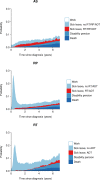Duration of sick leave after active surveillance, surgery or radiotherapy for localised prostate cancer: a nationwide cohort study
- PMID: 32156761
- PMCID: PMC7064067
- DOI: 10.1136/bmjopen-2019-032914
Duration of sick leave after active surveillance, surgery or radiotherapy for localised prostate cancer: a nationwide cohort study
Abstract
Objectives: To compare the loss of working time due to sick leave by treatment strategy for localised prostate cancer.
Design: Nationwide cohort study.
Setting: Sweden.
Participants: A total of 15 902 working-aged men with localised low or intermediate-risk prostate cancer diagnosed during 2007-2016 from the Prostate Cancer Data Base Sweden, together with 63 464 prostate cancer-free men. Men were followed until 2016.
Primary and secondary outcome measures: Using multistate Markov models, we calculated the proportion of men on work, sick leave, disability pension and death, together with the amount of time spent in each state. All-cause and cause-specific estimates were calculated.
Results: During the first 5 years after diagnosis, men with active surveillance as their primary treatment strategy spent a mean of 17 days (95% CI 15 to 19) on prostate cancer-specific sick leave, as compared with 46 days (95% CI 44 to 48) after radical prostatectomy and 44 days (95% CI 38 to 50) after radiotherapy. The pattern was similar after adjustment for cancer and sociodemographic characteristics. There were no differences between the treatment strategies in terms of days spent on sick leave due to depression, anxiety or stress. Five years after diagnosis, over 90% of men in all treatment strategies were free from sick leave, disability pension receipt and death from any cause.
Conclusions: Men on active surveillance experienced less impact on working life compared with men who received radical prostatectomy or radiotherapy. From a long-term perspective, there were no major differences between treatment strategies. Our findings can inform men diagnosed with localised prostate cancer on how different treatment strategies may affect their working lives.
Keywords: prostatectomy; prostatic neoplasms; radiotherapy; sick leave; watchful waiting.
© Author(s) (or their employer(s)) 2020. Re-use permitted under CC BY-NC. No commercial re-use. See rights and permissions. Published by BMJ.
Conflict of interest statement
Competing interests: ML owns Pfizer and AstraZeneca shares.
Figures


Similar articles
-
Work Disability After Robot-assisted or Open Radical Prostatectomy: A Nationwide, Population-based Study.Eur Urol. 2016 Jul;70(1):64-71. doi: 10.1016/j.eururo.2015.12.049. Epub 2016 Jan 15. Eur Urol. 2016. PMID: 26782345
-
Active monitoring, radical prostatectomy, or radiotherapy for localised prostate cancer: study design and diagnostic and baseline results of the ProtecT randomised phase 3 trial.Lancet Oncol. 2014 Sep;15(10):1109-18. doi: 10.1016/S1470-2045(14)70361-4. Epub 2014 Aug 19. Lancet Oncol. 2014. PMID: 25163905 Clinical Trial.
-
Causes of sick leave, disability pension, and death following a breast cancer diagnosis in women of working age.Breast. 2019 Jun;45:48-55. doi: 10.1016/j.breast.2019.02.012. Epub 2019 Mar 2. Breast. 2019. PMID: 30852409
-
Management of localised prostate cancer: watchful waiting, surgery or radiation therapy, depending on the natural course, which is often relatively slow.Prescrire Int. 2012 Oct;21(131):242-8. Prescrire Int. 2012. PMID: 23185849 Review.
-
Management of Localised Prostate Cancer in Kidney Transplant Patients: A Systematic Review from the EAU Guidelines on Renal Transplantation Panel.Eur Urol Focus. 2018 Mar;4(2):153-162. doi: 10.1016/j.euf.2018.05.010. Epub 2018 Jun 18. Eur Urol Focus. 2018. PMID: 29921544
Cited by
-
Human exposome assessment platform.Environ Epidemiol. 2021 Dec 3;5(6):e182. doi: 10.1097/EE9.0000000000000182. eCollection 2021 Dec. Environ Epidemiol. 2021. PMID: 34909561 Free PMC article.
-
Ten-year work burden after prostate cancer treatment.Cancer Med. 2023 Sep;12(18):19234-19244. doi: 10.1002/cam4.6530. Epub 2023 Sep 19. Cancer Med. 2023. PMID: 37724617 Free PMC article.
References
Publication types
MeSH terms
Substances
LinkOut - more resources
Full Text Sources
Medical
